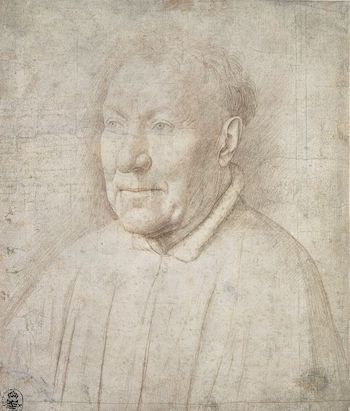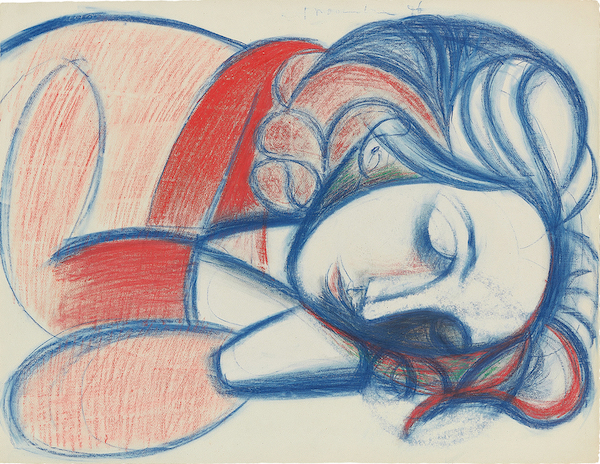Letter from New York — Dresden Treasures, and Lots of Picasso
By David D’Arcy
New York has come back to life, so there is more art to see than anyone has time to visit or write about.

Jan van Eyck, Portrait of an Older Man, c. 1435–40, silverpoint and goldpoint on white prepared paper. Photo: Herbert Boswank
One of the best shows currently on view is at the Morgan Library and Museum. Van Eyck to Mondrian: 300 Years of Collecting in Dresden would be a valuable exhibition if just a single one of those drawings were on view. The show is more than that, much more, but one drawing by Jan Van Eyck (before 1390-1441) is worth your visit.
The picture is of a 60-ish man, with aging eyes and skin, his hair cut through the use of a bowl (or so it seems), and a bulbous nose. He is dressed like a member of an aristocratic court (on the low rank). Think of this man as more of a character actor than an early Renaissance leading man. With that in mind, you can see why an artist who mastered precision like van Eyck would have been drawn to all the particularities of such a face — not grotesque or dramatic or regal, but real. It is the only surviving drawing that can be attributed definitely to van Eyck.
The man’s gaze is steadfast but weary. His lips are clenched firmly. The image is a paradox, a tour de force depiction of a man at an ordinary moment. Drawn in metal-point on fine paper, the man’s features are so finely modeled that the lines made by the artist feel sculptural, like an improbable frieze on a flat slab of stone. Van Eyck’s painted portrait of the same man is in Vienna.
Across from this masterpiece is another memorable drawing, a self-portrait in black and red chalk by Anton Raphael Mengs, from 1740, when the artist was 12 years old. Cue the Mozart comparisons. In this work of stunning self-assurance, there is nothing to suggest that this portrait of a child — serious, anything but cute, and certainly not seeking to please the viewer — was completed by a child.
There is an immediacy to Mengs’s picture of himself, suggesting that the young artist was standing before a mirror, looking back and forth between the mirror and the paper on which he was drawing. We see an impressive and seemingly effortless exactitude here, but also the flair of illusion: Mengs is trying to make himself look older than his 12 years. It would be another 11 years before Mengs became a senior court painter in Dresden, at 23.
Dresden, which has one of Germany’s finest collections, has a tortured 20th-century history. The museum and its drawings holdings came under Nazi control after Hitler’s rise to power, and “degenerate art” by artists like Ernst Ludwig Kirchner (1880-1938) came under scrutiny.
The show includes a drawing by Kirchner, who was known for announcing his intention to “draw to the point of madness.” In The Bathers (1910-11), Kirchner drew nudes with a hard, raw line and a frank, unapologetic sexuality — the very kind of figures that the Nazis would condemn as “degenerate.” German museums were forced to sell this type of art. One wonders how The Bathers escaped that fate.
The museum buildings in Dresden were destroyed in the Allied bombings in February 1945 that killed some 300,000 people. Nazi officials moved the collections off-site, saving most of the works, but Soviet forces carted the art off after they seized the city. The art was returned (most of it) in 1956, partly in recognition of the East German government’s refusal to support the Hungarian Uprising against the Soviet occupation that year. Even with its art returned and its galleries reconstructed, Dresden was part of a stern East Germany, a country that was mostly off tourist itineraries until German reunification in 1990.
This history makes Girl’s Head, in Profile to Left, by A.R. Penck, from around 1963, worth a close look. Created by the Dresden-born Penck (the nom de plume of Ralf Winkler, 1939-2007), this iconic androgynous head, which could just as easily be of a boy as of a girl, draws more on Kirchner’s angular grotesquerie than on the socialist realism that was mandated by the German Democratic Republic in those days. Some might see it as a harbinger of the extraterrestrials that took over pop culture in the following decade. Penck, a youthful troublemaker denied access to the best art schools, managed to capture an aloofness in this subject that feels impenetrable, the very attitude that officials would condemn. It’s a tribute to curators that they acquired the drawing by an already suspect artist, at a time when doing anything suspect could get you into serious trouble. And where else would you see A.R. Penck today in a show with Jan van Eyck?

Pablo Picasso, Portrait de femme endormie, III [Portrait of Sleeping Woman, III]
Antibes, November 1, 1946.
No one needs to be told that Picasso could draw. His range will still surprise many here — tender portraits of lovers and pictures intended to shock those same subjects, exquisite surreal abstractions and homages to classical figures in the Mediterranean sun, scenes of lavish color and faces (including one presumed late self-portrait) in the pallor of conflict and loss. Be prepared for an artist who was capable of almost anything. You can preview all 86 works on the gallery’s website, which is absolutely worth a visit even if you can’t get to New York.
The exhibition at Acquavella, three blocks from the Met, has no admission charge. For some reason, the public hasn’t been swarming to the show, as visitors did when Picasso biographer John Richardson curated some extraordinary Picasso exhibitions (also with free entry) at Gagosian Gallery. There is no excuse to miss this show, which runs through December 3.

Oscar Bluemner, Red Town, Montclair, NJ, 1917.
At The Art Show, the annual art fair organized by the Art Dealers Association of America (November 3-7), works on view tended toward the contemporary. The market seems to have jumped back to life — if you believe the dealers there. Still, the standouts, for me, were the works that were a bit out of sync with current trends. Oscar Bluemner (1867-1938), the German-born American modernist, abandoned a 20-year career as an architect for painting. Bluemner is now best-known for his head-on self-portraits and for his scenes of New Jersey landscapes and rural structures, with a penchant for vivid reds so rich that he was nicknamed “the vermillionaire.” Even with that palette, Bluemner’s paintings exude a powerful chill, a European restraint applied to American subjects. The gallery Menconi + Schoelkopf opens a Bluemner retrospective in New York this week.
Around a corner at The Art Show, the sculptor Larry Bell was back, exhibiting geometric constructions in glass, all variations on the glass box that the artist has been exploring for decades. Bell is now 81, an age at which few artists are described as contemporary. His new works, on view at the booth of Anthony Meier Fine Arts of San Francisco, are what might be called desktop versions of his favorite motif. Critics would say that Bell is up to the same old thing. But the box, when Bell takes it apart and rearranges its elements, produces endless variations. Light passing through and reflecting from the glass inspires an infinity of forms. The evidence was there.
A few booths away, at the stand of David Tunick Inc. Prints and Drawings, a 1910 drawing of two women by Ernst Kirchner was an example of the artist’s practice at the time to sketch models who posed for only 15 minutes. At the time, drawing was playing catch-up with the spontaneity of photography. On the same wall was Les deux saltimbanques, a tiny framed print of two barefoot child acrobats (saltimbanques) by Picasso from 1905, the end of his Blue Period. The print is in black and white, signed and dedicated to the poet Guillaume Apollinaire, one of Picasso’s closest friends and strongest advocates. Records indicate that the only other impression of this work is in the Boston Museum of Fine Arts. You can’t escape Picasso in New York right now. Life could be worse.
David D’Arcy, who lives in New York, writes about art for many publications, including the Art Newspaper. He produced and co-wrote the documentary Portrait of Wally (2012), about the fight over a Nazi-looted painting found at the Museum of Modern Art in Manhattan.
